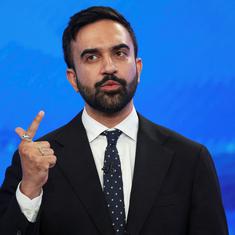As the Bharatiya Janata Party prepares for another two years of Amit Shah at the helm, it's pertinent to look back at just how the party fared under the controversial former home minister of Gujarat. There are lots of ways to evaluate the performance of a party president, from shifts in ideology to inducting new talent and acquiring new allies. But it's not called electoral politics for nothing: at the end of the day, it all comes down to performance at the ballot box.
Amit Shah built up a reputation for being a master strategist, in part because the successes he engineered for Modi showings in Gujarat. He then took on the job of organising the BJP's campaign strategy for Narendra Modi in the run-up to Lok Sabha elections in 2014, with a focus on Uttar Pradesh.
The results were undeniable: Where no party earlier might have expected more than 40 Lok Sabha seats out of UP's 80, the BJP managed to rack up an unbelievable 71 by itself, and two more from an ally. Those sort of numbers are hard to attribute to a fluke.
Coming alongside the BJP's astonishing performance around the country, where a Narendra Modi wave managed to result in the first single-party Lok Sabha majority in 30 years, Shah suddenly became unassailable. His political career was put on a fast-track, and once former BJP president Rajnath Singh stepped down so he could become a cabinet minister, Shah took over the reins.
His aims were two-fold. Sensing the opportunity to become a truly national party on the back of Modi's popularity, which had given the BJP surprising votes in entirely new territories like Kerala and West Bengal, Shah focused on expanding the party. He also had to be aware of the one thing that stood in Modi's way, the Rajya Sabha – where the BJP is still in a minority. To get over this, Shah had to make sure the BJP didn't just begin competing in new territories, but also keep its stranglehold on the states it was expected to win.
One of the ways Shah wanted to do this was to focus on going it alone, having the BJP attempt to win elections without a major alliance partner in the hopes of getting a simple majority. This was part of the rationale behind ending a 25-year alliance with the Shiv Sena in Maharashtra, just before elections there.
On this, Shah's record is actually quite spotty. His first year is lauded as having included three electoral victories, but a closer looks suggests that only one of those is an unqualified success.
In Maharashtra, Haryana and Jammu and Kashmir, all of which had assembly elections in 2014, the BJP managed to pull in more seats than it had in the previous state election. Vote share also perked up across the board, undoubtedly a positive sign for the party. Yet only in Haryana did this turn into a simple majority.
In Maharashtra, the BJP had to once again make common cause with the Shiv Sena, an uncomfortable alliance that remains tense even today, although it's unlikely to fall apart anytime soon. And in Jammu and Kashmir, the BJP swept Jammu but was washed out in the Kashmir Valley, forcing the party into another unnatural alliance with the People's Democratic Party.
Still, the BJP managed to come to power in all three states that went to the polls in 2014. The following year, however, was an unmitigated disaster. The BJP was completely routed in Delhi, where it went from having 31 seats in the 70-member Assembly just a year and a few months prior, to three seats in all. In Bihar, likewise, despite initially appearing to be the frontrunner, the party was dealt a sound defeat.
While vote share seems to have increased in all states, when measured against previous assembly polls, a rough comparison against the vote share percentage in the 2014 Lok Sabha polls is also telling. There has always been a question about how much of the BJP's success in 2014 was because of an anti-Congress sentiment that Modi managed to brilliantly channel, and how much of it is because of true swing towards the BJP.
Outside of Maharashtra, where the BJP was contesting more seats after breaking a 25-year-old alliance, the BJP lost vote share in every state that went to the polls after the 2014 Lok Sabha elections. Some of this is naturally because of evolving electoral calculations, such as the decision of rival parties to come together in Bihar as a way of combatting the BJP, but it nevertheless highlights the difference between the voter's support for an anti-Congress Modi and a true groundswell in favour of the BJP.
In some ways, this makes Shah's job over the next year slightly easier. Of the four states going to the polls in 2016, the BJP can only seriously expect a victory in Assam. West Bengal, Tamil Nadu and Kerala will all be opportunities for the party to expand without having too many expectations. But 2017 – with Punjab and UP coming up – will be a different matter altogether.












